Nikon Series E 28mm
f/2.8s wideagle lens
compare this with
the autofocus (AF-NIkkor) 28mm AF-S/D versions and/or compare the Manual Focus versions of the Nikkor
28mm lens group
A light weight, compact and an economical entry into the wideangle photography. The first version of
the Series E optic was introduced back in November, 1979. Early version was not provided
with a metal lens mounting ring and have a double row square plastic textured focusing
ring.
 |
The second versions saw some improvement after heavy criticism, it was replaced with a double row rubberized grips which is closer to the physical appearance of other Nikkor lenses. Further a narrow Aluminum lens mounting ring was added for a firmer grip as previously it was a plastic. However, on a positive note - the lens has a very compact design and it weighs very light merely 150g !), attributed from an exclusive 5 elements in 5 groups optical construction and further, despite its relatively weak elements present, optically, the lens is very sharp and images produce are of high contrast and has uniform color fidelity. The lens was not provided a meter coupling prong (rabbit ears) on its aperture ring and may not be usable for full aperture metering with non-Ai Nikon SLR camera bodies. |
The 28mm's 74° makes it an ideal lens for a wide varieties of photographic applications. The standard 52mm filter attachment size also provides useful interchangeability with many of Nikon accessories. Be it for family photographic session, fashion, travel, scenic, portrait or any other general usage. It is especially a good companion lens to the compact Nikon EM, FG, FG-20 or even many other Nikon SLR bodies. For those who finds they may need an economical good all round wideangle lens to supplement their zoom lenses for covering PR photography, this lens may perhaps fills your requirement handsomely. Since the lens carries an AI-s lens coupling system at its rear, it can also provides multi program functions with suitable Ai-Nikon SLR bodies.
 |
Technical Highlights: * Wide picture coverage of 74° is convenient for general photography. * Exceptionally light - weighs only 155 grams. * Nikon Integrated Coating is applied to maintain high contrast and faithful color rendition. *Uses popular 52mm filters. * Suitable for general photographic situations, such as candid, landscapes, and travel or just use your creativity in all aspect of photography. |
Supplementary Nikkor information: The manual focus Nikkor 28mm f/2.8s has a 8 elements in 8 groups optical arrangement and focuses down to an impressive 0.2m (0.7 ft.) with CRC system employed within its design. The current AF-D 28mm f/2.8 uses a 6 elements in 6 groups design and closes down to 0.25m (1.5 ft).
Note: Serial Number for the Nikon Series-E 28mm f/2.8 may have been started from 1790601 for the early version. Second version was unknown.
 |
Unlike the Nikkor 28mm f/2.8 lens, CRC system is not used in the new lens. The E series 28mm was also came with a f2.8 maximum aperture but optically was a simpler 5 elements in 5 group design. The biggest difference is the weight, it is the lightest and the most compact among the few versions mentioned earlier (Nikkor 28mm weighs 250g, the AF version is 225g and the Series E only weighs 155g!). |
 |
Specifications: |
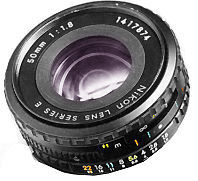 |
 |
Filters: 52mm front screw-in; Front lens cap: Snap-On |
Warning: Certain AE modes (Programmed AE and Shutter Priority AE) on selective Nikon SLRs will not work efficiently with older TC devices. Use an Ai-S version for better compatibility, read the respective Tele-Extender(s) sections.
* Used used with selective earlier AF camera models such as F801, F501 etc., these camera may able to convert the manual focus lens into limited function autofocus lens. However, the focal length will be magnified 1.6X. while the effective aperture will be reduced 1 1/3 stop. The TC-14A much later in the late eighties may also be used as an manual focal length magnifier of 1.4X, the effective aperture will be reduced by 1 stop. Some limitation may apply, check with your local Nikon distributor for further details before use.
Nikon Series E 35mm f/2.5s widenagle lens compare this with the AUTOFOCUS version and/or compare the Manual focus versions of the Nikkor 35mm lens group
Probably a good alternative to the more expensive Nikkor wideangle lenses if cost is a factor to consider. This lightweight, extremely compact design was a result of a simple 5 elements in 6 group design. But the compromise is a very plasticy construction which makes ones very uncomfortable over its durability. The meter coupling prong has been omitted in its design and thus users of older non-AI spec SLR bodies have to be careful as full aperture metering may not be possible. The original version has an all plastic construction and second version introduced in May, 1981 has a metal aluminum lens mounting ring being added. Further, the dual row square sized plastic grips on its focusing ring was reverted back to rubberized grip design. The NIC coating perhaps has contributed to its uniform high contrast, neutral colour rendition. The lens is a good, cheap alternative for those who are seeking for a plain normal wideangle lens, provided you can live with its less rigid body construction.
 <<<<---- second version |
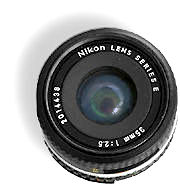 |
Technical Highlights: * Wide picture coverage of 62° - just right for snapshots. * Exceptionally light - weighs only 150 grams. * Nikon Integrated Coating was applied for improved contrast and color fidelity. * Matches the coverage of most electronic flash units. * Accepts standard 52mm filters. * Probably a good choice for snapshots, candid, landscapes, travel and general photography if weight is your prime concern. |
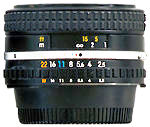 |
 |
This lens projects a slightly brighter viewfinder image than the Nikkor 35mm f2.8 with its f2.5 maximum aperture. Weighing only 150g, slightly heavier than the Series E 50mm f1.8, these two lenses are the lightest among all the Series E lenses and probably among all 35mm optic produced by Nikon which includes the Nikkor lenses. It has a slightly tinted greenish reflection on its front element coating. As Nikon does has a few excellent Nikkor wideangle lenses at this 35mm focal length. But the 35mm Series E here is the cheapest option among all Nikkor consideration, especially it is not impossible to source one good, used unit from the used market. |
Specifications
Focal length/Aperture: 35mm f/2.5; Lens construction: 5 elements in
5 groups
Picture angle: 62°; Diaphragm: Automatic
Aperture scale: f2.5 - f22 on both standard and aperture-direct-readout scales
Exposure measurement: Via full aperture method with AI cameras; via stop-down
method with non-AI cameras.
Distance scale: Graduated in meters and feet from 0.3m (1 ft.) to infinity
(oo)
Weight: 150g; Dimensions: 62.5mm dia. x 44.5mm long (overall); 35mm
extension from lens flange
Filters: 52mm front screw-in; Front lens cap: Snap-On
Lens hood: HR-4 screw-in rubber type
Lens case: CL-30S hard leatherette, No. 61 soft pouch, or CP-8 plastic
Usable teleconverter(s): TC-200,
TC-201,
* TC-16AS,
*TC-14A
Warning: Certain AE modes (Programmed AE and
Shutter Priority AE) on selective Nikon SLRs will not work efficiently with older
TC devices. Use an Ai-S version for better compatibility, read the respective Tele-Extender(s)
sections.
Note: Serial Number for this lens could have been started with 1880801. Unknown for the subsequent version.
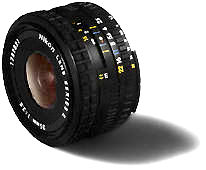 |
* Used used with selective earlier AF camera models such as F801, F501 etc., these camera may able to convert the manual focus lens into an AF lens. However, the focal length will be magnified 1.6X. while the effective aperture will be reduced 1 1/3 stop. The TC-14A may also be used as an manual focal length magnifier of 1.4X, the effective aperture will be reduced by 1 stop. Some limitation may apply, check with your local Nikon distributor for further details before use. |
Nikon Series E 50mm f/1.8s standard lens
(Compare this with the Autofocus
early AF-S/D versions)
OR Manual focus Nikkor 50mm f/1.2(s) f/1.8s/n /
f/1.4(s)(N)
section
First introduced in December, 1978. Probably the first lens that might be sold to
you when you bought any of the super compact camera models such as the EM, FG or
the FG-20 SLR cameras. The lens employs a 6 elements in 5 groups optical design and
enables it to close focus down to 2 ft. There is no metering coupling prong to be
use for non-AI Nikon SLRs and early versions do not provide a metal lens mounting
ring, thus making it looks almost an all matte black finished lens in appearance.
The second version saw some physical improvement made to its revised design where
an Aluminum lens mounting ring was added and its finishes are less plasticy. The
update also increased its weight slightly by about 20g from the original version.
The focusing ring has only a very narrow single row rubberized grip which is quite
uncomfortable to use.
 |
 |
Credit: Image(s) displayed here are courtesy of betteroffblu/Jenny® where the EBAY STORE is also one of my favorite spot to look for great images on used photographic equipment. Image(s) copyright © 2006. All rights reserved. Please respect the visual property of the contributing photographer.
The AF Nikkor 50mm f/1.8 closely resembles the design of the Nikon 50mm f/1.8E lens which many believes the AF lens was a direct replica of the Series E optical design in an AF shell. Whatever it is, despite its weakly physical appearance which exhibits less rigid feel than any Nikkor counterpart, optically this lens performs otherwise. The Nikon NIC coating provides the lens a distinctive purplish front lens elements which contributed to its exceptional sharpness and neutral color rendition. Images are consistently of high contrast and this lens is also an excellent choice for close up when using it with attachment units such as bellow or extension ring. The lens can used both metal and rubber lense hood.
 |
 |
Technical Highlights: * Picture coverage of 46° produces pictures with natural perspective. * Relatively fast f/1.8 maximum aperture provides bright and easy-to focus images in the viewfinder. * Remarkably light at only 135 grams. * Stops down to f/22 for additional depth of field. * Takes 52mm filters. * Popular for general photography - scenery, children, and landscapes. |
 |
This lens should be cheaply priced at used prices, it has almost a similar optical construction as with the current AF 50mm f1.8 (6 elements in 5 groups); almost comparable in its closest focusing distance (0.6m (2ft.) against the AF model's 0.45m (1.5 ft)) but it is lighter in weight (135mm against 155g). In fact, you can say it is an AF Nikkor 50mm f1.8 without an autofocus feature. |
Credit: Image courtesy of Eileen "Sales@UsedNikon". where the Company trades some selective photo equipment. Image(s) copyright © 2003. All rights reserved. Please respect the visual property of the contributing photographer. |
|||
Specifications:
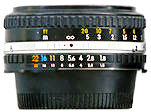 |
Focal length/Aperture: 50mm f/1.8 |
Diaphragm: Automatic
Aperture scale: f/1.8 - f/22 on both standard and aperture-direct-readout
scales
Exposure measurement: Via full aperture method with AI cameras; via stop-down
method with non-AI cameras.
Distance scale: Graduated in meters and feet from 0.6m (2ft.) to infinity
(oo).
Weight: 135g; Dimensions: 62.5mm dia. x 33mm long (overall); 24mm extension
from lens flange
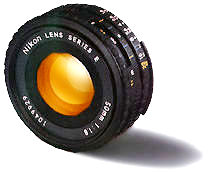 |
Filters: 52mm front screw-in; Front lens cap: Snap-On |
* Used used with selective earlier AF camera models such as F801, F501 etc., these camera may able to convert the manual focus lens into an AF lens. However, the focal length will be magnified 1.6X. while the effective aperture will be reduced 1 1/3 stop. The TC-14A may also be used as an manual focal length magnifier of 1.4X, the effective aperture will be reduced by 1 stop. Some limitation may apply, check with your local Nikon distributor for further details before use. Warning: Certain AE modes (Programmed AE and Shutter Priority AE) on selective Nikon SLRs will not work efficiently with older TC devices. Use an Ai-S version for better compatibility, read the respective Tele-Extender(s) sections. Note: Serial number for this lens began with 1050011 for the earlier version, numbering for subsequent version is unknown.
| Back |
to Index Page of Series E lenses
| Back | to Index Page
Nikon
Series E lenses:-
28mm | 35mm | 50mm
| 100mm | 135mm | 36-72mm | 75-150mm | 70-210mm
 |
||
| | Nikon EM, 1979 | | | Nikon FG, 1982 | | | Nikon FG20, 1984 | |
Specifications :
Nikon
EM, Nikon FG, Nikon FG-20
Additional info available on : MD-14 | MD-E | SB-15
| SB-E | MF-15 Databack
| Message
Board
| for your favourite
Nikon
SLR models Questions,
issues & Answer(s)
| Message Board | for your Nikon Optics in a shared environment
| Message Board |
Specifically for Dispose or Looking for Nikon/Nikkor Photographic
Equipment
| Back | to Main Index Page of Pictorial History of Nikon SLRs
 |
The Eyes of Nikon:- |
Fisheye-Nikkor Lenses - Circular | Full Frame | Ultrawides Lenses - 13mm15mm18mm20mm | Wideangle Lenses - 24mm28mm35mm |
Standard Lenses - 45mm 50mm 58mm | Telephoto Lenses - 85mm105mm135mm180mm & 200mm |
Super-Telephoto Lenses - 300mm 400mm 500mm 600mm 800mm 1200mm |
Special Application lenses:
Micro-Nikkor Lenses - 50mm~55mm -60mm 85mm -105mm 200mm Micro-Zoom 70-180mm
Perspective Control (PC) - 28mm 35mm PC-Micro 85mm
Dedicated Lenses for Nikon F3AF: AF 80mm f/2.8 | AF 200mm f/3.5 EDIF
Depth of Field Control (DC): 105mm 135mm
Medical Nikkor: 120mm 200mm
Reflex-Nikkor Lenses - 500mm 1000mm 2000mm
Others: Noct Nikkor | OP-Nikkor | UV Nikkor 55mm 105mm | Focusing Units | Bellows-Nikkor 105mm 135mm
Nikon Series E Lenses: 28mm35mm50mm100mm135mm | E-Series Zoom lenses: 36~72mm75~150mm70~210mm
MF Zoom-Nikkor Lenses: 25~50mm | 28~45mm | 28~50mm | 28~85mm | 35~70mm | 36~72mm E | 35~85mm | 35~105mm | 35~135mm |
35~200mm | 43~86mm | 50~135mm | 50~300mm | 70~210mm E | 75~150mm E | 80~200mm | 85~250mm |
100~300mm | 180~600mm | 200~400mm | 200~600mm | 360~1200mm | 1200~1700mm
Tele-Converters: TC-1 | TC-2 | TC-200 | TC-201 | TC-300 | TC-301 | TC-14 | TC-14A | TC-14B | TC-14C | TC-14E | TC-16 | TC-16A | TC-20E
![]()
Nikon F
| Nikon F2 |
Nikon
F3
| Nikon F4 |
Nikon
F5
| Nikon F6 |
Nikkormat / Nikomat |
Nikon FM
| Nikon FE/ FA | Nikon EM/FG/FG20 | Nikon Digital SLRs | Nikon - Other models
MIR Supports for Photographic Community: Various Message Boards/Community
Forums
Nikon
F-series|
Nikon
F2-series|
Nikon
F3-series|
Nikon F4-series| Nikon
F5-series|Nikkormat/Nikomat-series
Nikon FM-series|Nikon
FE-series|Nikon
FA|Nikon
Digital
SLR
series|Various
Nikon
Models|Nikkor
Optic
-shared
Others:- Free Trade Zone - Photography| Free Trade Zone - Business Community |Free To Zouk - Photographic Community
Apple's Mac Public Community Message Board | Windows based PC &
Apple/Mac
Public Community Trade Exchange Centre
Recommended links to understand
more technical details related to the Nikkor F-mount and production Serial Number:
http://rick_oleson.tripod.com/index-153.html by: my friend, Rick Oleson
http://www.zi.ku.dk/personal/lhhansen/photo/fmount.htm by: Hansen, Lars Holst
http://www.mir.com.my/rb/photography/hardwares/nikonfmount/lens2.htm
http://www.photosynthesis.co.nz/nikon/serialno.html
About this photographic site.
HOME - Photography in Malaysia |
Copyright © 2000. leofoo ®. MIR Web Development Team.
Credit: My nephew, EeWynwho has helped to convert the Owner's Manual of Nikon EM into HTML format. Also to a smart friend of mine who has just spent US60-00 for a EM body. A contributing site to a long lost friend on the Net. Made witha PowerMac